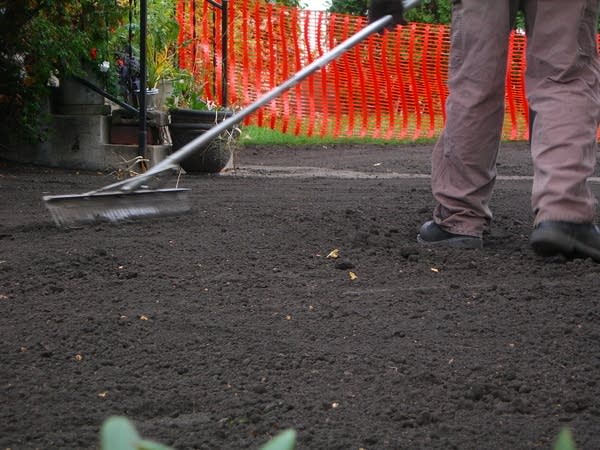Frustration and fear persist over arsenic contamination in some Minneapolis neighborhoods

On an early fall day, workers with shovels are digging soil from the front yard of a house in the Corcoran neighborhood in Minneapolis, while others are on small tractors.
They're with the U.S. Environmental Protection Agency, and they are removing a foot of soil contaminated with arsenic. It's what these workers have been doing almost every day since the summer.

The homes undergoing cleanup fall under a Superfund emergency program, because they have high levels of arsenic considered to be an immediate threat to public health.
A big truck pulls up in front of the house to collect the contaminated soil.
Create a More Connected Minnesota
MPR News is your trusted resource for the news you need. With your support, MPR News brings accessible, courageous journalism and authentic conversation to everyone - free of paywalls and barriers. Your gift makes a difference.
"You're going to see the guys getting inside the truck right now to place the liner on the bed of the truck," says Sonia Vega, who is overseeing this cleanup for the EPA. "The contaminated soil from the property is dumped within the liner, the liner is wrapped like a burrito and sealed, and that's how it goes out to the landfill."
Another truck will bring clean topsoil the workers will use to fill the yards.
All this activity has generated lots of questions from nearby residents, especially those whose yards aren't getting cleaned up. Lin LaPoint bought his home in Corcoran three years ago. He says information about the cleanup was hard to come by.

"It was just trucks showing up in your yard early in the morning and waking you up to the sounds of the dump trucks. And all the porta-potties being set up on the street for the workers, and no information," LaPoint says.
The arsenic in the soil of homes in south Minneapolis came from a grasshopper pesticide plant that operated at the corner of Hiawatha Ave. and 28th St. for 50 years, until 1968. The wind carried arsenic-contaminated dust from the plant to homes and businesses throughout the neighborhoods.
The arsenic was discovered at the plant in 1994 during planning for the Hiawatha light rail line. The levels of soil and groundwater contamination at the plant were considered lethal.
State and federal officials say they've done everything to explain the plant history and cleanup to residents, through mailings in multiple languages and community meetings.

Many of the answers they've gotten at these meetings have been confusing and unsettling, says Heidi Adelsman, a parent of two who lives in Longfellow. She also works as a community journalist for a local newspaper.
"We look like we're crazy people. And they wonder why we're crazy, when we've got at least four different state and national agencies involved who are offering four different standards for what is safe for our children," says Adelsman. "In the meantime, our children are growing up in community that is a Superfund site. Why are we not to think that this is a catastrophic public health problem?"
The Minnesota Pollution Control Agency, the Minnesota Department of Agriculture, the Minnesota Health Department, and the U.S. EPA have all been involved in the cleanup.
The state didn't begin testing homes until 2001. The Agriculture Department was put in charge, and started out by testing 20 homes. By 2003, it sampled about 200.

The process has been a long one, says Cathy Villas-Horns, a supervisor at the Agriculture Department.
"Once we identify the probable source of the contamination -- that it came from this pesticide company -- we are obligated to identify the responsible parties," Villas-Horns says.
Once the companies were identified, they began soil testing at the plant site, a process that took almost six years. It took a total of 11 years to complete the cleanup of the pesticide plant.
It was after conducting residential soil sampling that the Agriculture Department realized the contamination problem was bigger than the state could handle.
"We saw that we had a potentially large problem and we asked EPA to get involved," Villas-Horns says.
The EPA took over sampling of soil at homes in October 2004, and initiated the cleanups right away.

This long process has left people with lots of questions, says Longfellow resident Heidi Adelsman.
"There was a woman who was at the last meeting in July who said, 'I've grown up in this neighborhood myself and I have a 14-year old daughter who has a learning disability. Could that have anything to do with it?'" says Adelsman. "Other people will come and say, 'You know, my dog died of cancer. Why? Could that have anything to do with it?'"
That's the main question residents have. Are cancers in these south Minneapolis neighborhoods somehow linked to the arsenic in the soil?
"The answer is pretty much no," says Rita Messing, an environmental health supervisor at the Minnesota Department of Health.
The Health Department has no evidence that arsenic is causing an increase in cancer in south Minneapolis, Messing says.
"If there are elevations, it is mostly in lung cancer, which is probably a function of cigarette smoking," says Messing. "And even if arsenic contributed, the cigarette smoking effect would just overwhelm the arsenic effect."
The Health Department is planning an arsenic biomonitoring program in these neighborhoods. The study will measure the level of arsenic in children's bodies. But the tests will not show whether the arsenic is making the children sick.
The EPA will provide more about information arsenic exposure in south Minneapolis when it releases results of its health risk assessment Tuesday night. The assessment is aimed at calculating the long-term risk for exposure to arsenic in the soil.
Tuesday's meeting will be held at the Midtown YWCA at 2121 E. Lake St. in Minneapolis from 7-8:30 p.m.
